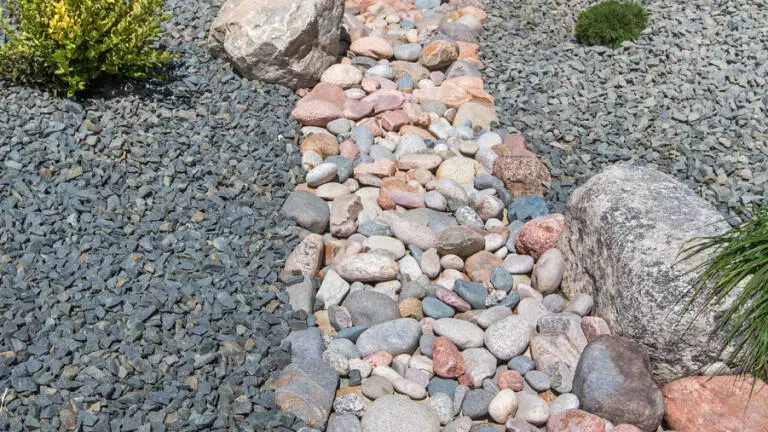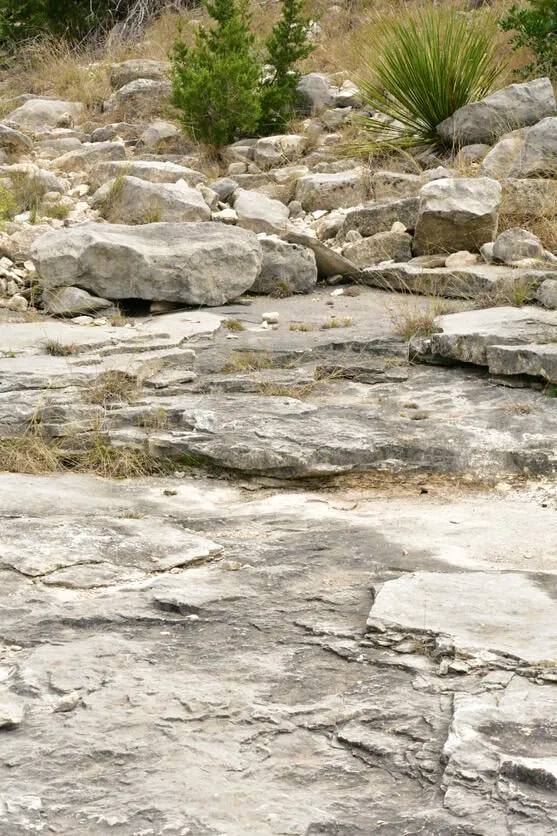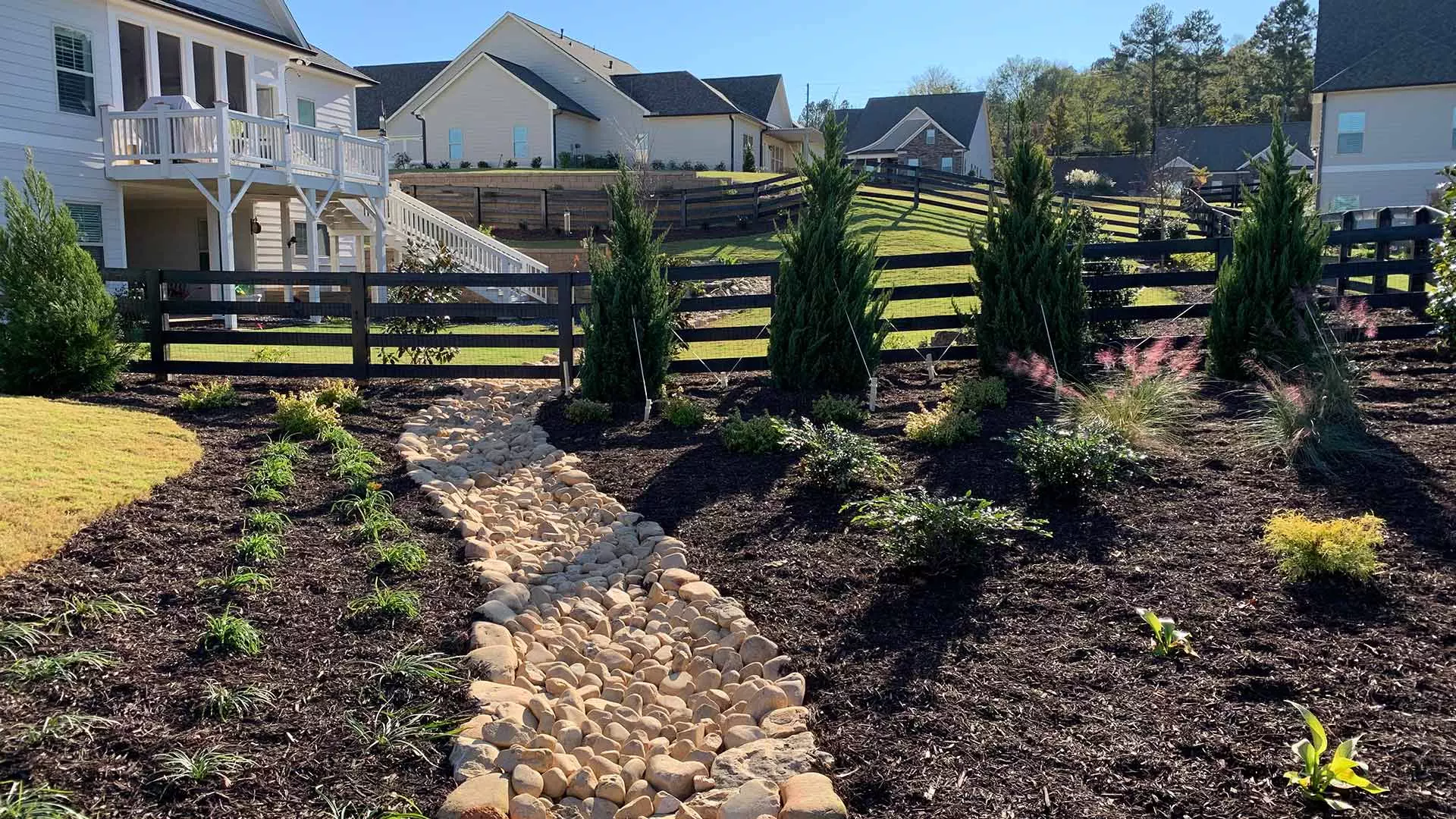Dry Creek Bed Ideas
Do you have backyard flooding issues? How about holes in your yard that collect standing water? Or has the natural flow of rainwater in your backyard created your very own lackluster Grand Canyon? Not only are flooding and drainage issues incredibly frustrating (insert swarms of mosquitos here!), they can cause a major hit to your pocketbook if the flooding has reached into the basement of your humble abode. Let’s do all we can to keep that from happening by implementing one of the following dry creek bed ideas!
If you have seen the red flags of erosion, standing water, or gullies in your landscape, we have the best solution for your problem – dry creek beds! Not only are the following dry creek bed ideas an aesthetic upgrade for your landscape, but they do double work by functioning as a natural flooding and water drainage solution.


- What is a dry creek bed?
- In the most basic of terms, a dry creek bed is nothing more than a trench or swale lined with decorative rock with the purpose of moving water toward or away from an area.
- Oftentimes, xeriscaping utilizes dry creek beds somewhere in the design layout.
- Appropriately designed dry creek beds can be a beautiful addition to your landscape while also serving an important purpose.
- How do you know if a dry creek bed is the best option for you?
- If you have standing water in your yard, constant leaking in your basement, or gullies that have overtaken your terrain, you should absolutely consider putting in a dry creek bed.
- What are the most important things to consider when looking at designing a dry creek bed?
- Where is the water coming from?
- Where do you want the water to flow?
Dry Creek Bed – Functions & Facts


The most important function of a dry creek bed is to help alleviate standing or flowing water in your yard, and to prevent storm water run-off from getting to your home.
In the United States 98% of basements will experience some sort of water damage at least once (Water Damage Statistics 2022).
By creating a channel for storm water to flow away from your home and toward an area-inlet or storm sewer, you are providing the simplest and most cost effective way of keeping water away from your home’s foundation.
However, a dry creek bed alone may not always fix the problem. If you consider that a 1,500 square foot roof (which isn’t that large by roof standards) can shed 1,000 gallons of water for every inch of rainfall, then it is easy to see how quickly all that rain water can turn into a torrential flood if your drainage system is blocked or undersized (Divine Roofing).
Ensuring that your gutters and downspouts are completely clear and draining properly is the first step toward a drier backyard. In general, it is always recommended to extend your downspouts several feet away from your home to ensure that water flows away from your foundation.
So how does a dry creek bed play into gutters and downspouts? A creative solution to getting the water from your downspouts away from your home is to have your downspouts terminate into a dry creek bed.
Drainage Easements & Landscape Design




With today’s congested urban sprawl, mass grading and construction of impervious surfaces has greatly impacted the natural flow and dissipation of storm water. Homeowners often discover drainage easements in their backyard. These drainage easements contain buried pipes, catch basins, and open drainage swales that are installed to direct water runoff away from homes and into retention ponds, creeks, and streams.
While these systems help with water flow and run-off, they can pose challenges in terms of landscaping. How can a landscape designer make a drainage ditch in your backyard into something that not only continues to function as a drainage ditch but is also an appealing garden feature?
Dry creek beds are the solution!!
In this instance, the dry creek bed is so much more than just a means of moving water out of your yard – it has now become an aesthetically pleasing attribute to your yard.
Dry Creek Bed Designs






Dry creek beds can incorporate:
- Multiple sizes of decorative rock
- Boulders
- Plantings
Designs like natural stone bridges crossing a creek make for a fun and interactive garden experience.
Dry creek beds can meander through the backyard crossing, through landscape beds, and this proves a more natural riparian look that not only gives your suburban home a “woodsy” feel, but also attracts wild life by providing habitat and food.
Planting native species (such as Cardinal Flower, Buttonbush, Milkweed, sedges, and switchgrass) along the banks of a dry creek bed can really help blend the natural beauty of a rain garden with our more traditional suburban landscapes.
Keep in mind, these dry creek bed ideas can simply be an artistic contribution to your landscape. Perhaps your goal is to create a natural looking landscape that transports you to the backwoods and away from the noise. I’d treat this application the same as I would a dry creek bed serving as a drainage swale – maintain a natural flowing path for the creek to follow, add undulations to the elevation by creating planting berms, incorporate varying sized rocks, and of course, natural hardy plantings to create a wildlife habitat. A dry creek bed can both be aesthetic and functional and can greatly enhance the look and feel of your backyard oasis.








We understand the headaches that come with water drainage issues. Let the experts problem solve your flooding issues! Contact us or submit a request for a free quote. Not only will a dry creek bed solve your water problems, you’ll be the envy of your neighbors – who needs to keep up with the Joneses when you are the Jones Family yourself!









